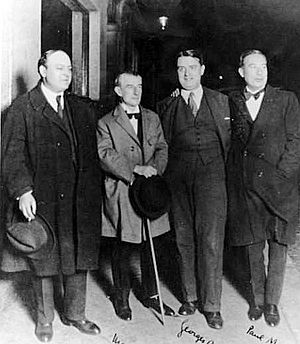Léon-Paul Fargue facts for kids
Quick facts for kids
Léon-Paul Fargue
|
|
|---|---|
| Born | 4 March 1876 Paris |
| Died | 24 November 1947 (aged 71) Paris |
| Occupation | Writer |
| Nationality | French |
| Period | 20th century |
| Genre | Poetry, essays |
Léon-Paul Fargue (born March 4, 1876 – died November 24, 1947) was a famous French poet and essayist. He was known for his special way of writing poetry that captured the feeling and details of places. He also loved the city of Paris very much.
Contents
Early Life and Writing
Léon-Paul Fargue was born in Paris, France. He started writing very early in his life. Before he was 19 years old, he had already published some of his work. His important poem Tancrède came out in a magazine called Pan in 1895.
Fargue's early writings often described his childhood. They also showed his love for nature and for exploring the streets of Paris.
Literary Connections
Fargue was a part of the Symbolist poetry group. This group was linked to a famous French magazine called Le Mercure de France. Symbolist poets used symbols and images to express ideas and feelings.
He did not agree with the ideas of the surrealists, another group of artists and writers. Famous writers like Rainer Maria Rilke and James Joyce thought Fargue was one of the best modern poets.
A Poet of Paris
Léon-Paul Fargue had a deep love for Paris, the city where he was born. He often wrote about its streets, cafes, and lively nightlife. Later in his career, he published two books specifically about Paris:
- D'après Paris (1931)
- Le piéton de Paris (1939)
These books showed his unique view of the city. He explored its hidden corners and described its everyday life.
Social Life and Friendships
Fargue was a very popular person in the literary world of Paris in the 1920s and 1930s. He was known for his charm, quick wit, and amazing storytelling.
The German writer Walter Benjamin met Fargue in 1930. Benjamin called Fargue "the greatest living poet in France." Fargue once told Benjamin a story about a special dinner he hosted. At this dinner, his old friend Marcel Proust met James Joyce. This was the only time these two very famous writers ever met.
A writer named Leon-Pierre Quint described Fargue in 1929. He said Fargue spoke as he wrote, always with clever jokes and puns. Quint also mentioned Fargue's childlike love for Paris. He noted that Fargue worked during the day and was always out at night.
Music and Legacy
Léon-Paul Fargue was a close friend of the famous composer Maurice Ravel. Fargue was also a member of a group of artists and musicians called Les Apaches. This group shared a love for new and exciting art.
Ravel even set one of Fargue's poems, called Rêves (Dreams), to music in 1927. This shows the strong connection between their artistic worlds.
Fargue passed away in Paris in 1947. He is buried in the Cimetière du Montparnasse. The composer Federico Mompou dedicated one of his musical pieces, No. 12 of his Cançons i Danses, to Fargue's memory.
Selection of Published Works
- Poèmes, 1905
- Nocturnes, 1905
- Tancrède, 1911
- Pour la musique, 1912
- Banalité, 1928
- Vulturne, 1928
- Épaisseurs, 1929
- Sous la lampe, 1929
- Ludions, 1930
- D'après Paris, 1932
- Le Piéton de Paris, 1939
See also
 In Spanish: Léon-Paul Fargue para niños
In Spanish: Léon-Paul Fargue para niños


